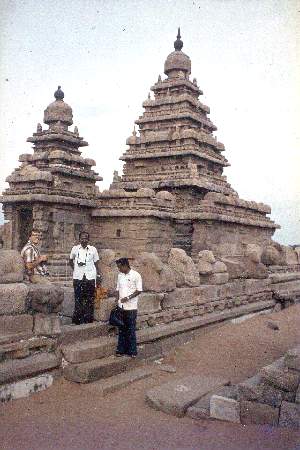

Home | Biodata | Biography | Photo Gallery | Publications | Tributes
Archaeology

 |

Home | Biodata | Biography | Photo Gallery | Publications | Tributes Archaeology |
 |
The Kailasanatha temple of Kanchipuram built by the famous Pallava king Rajasimha around 700 A.D. has patches of paintings in the small shrines which surround the courtyard of the main shrine. This fact was discovered several decades ago by the French scholar, G. Jouveau-Dubreuil.
On the eastern and western sides of the courtyard, each of the small shrines has inside on the back wall a carved Somaskanda panel in stone. The Somaskanda theme shows Siva, Uma, and Skanda seated on a royal throne. The Archaeological Survey of India has removed the top layers of modern plaster and revealed bright colours on these sculptures. Some of the shrines on the northern and southern sides have remnants of paintings on the walls. We have noted up to four separate layers of paint on them.
Do any of the fragments of paintings in the temple belong to the Pallava period? What would be the methods of dating such early paintings and answering this question? Since the paintings are found on shrines built by Rajasimha, obviously the paintings are not older than the buildings. But how does one find out whether they are not much later?
One method would be to remove the upper layers of paint until one reaches the lower-most layer. If this bottom layer were on well-preserved stone surface, it would represent the earliest painting. However, if the building material is sandstone in the Kailasanatha temple, there is no easy way of knowing whether the original layer had not peeled off and someone had painted it subsequently. As a matter of fact, there is a Chola inscription on the inner wall of one shrine which was subsequently covered by thick plaster till very recently.
Another method would be to date a painting on stylistic grounds. This method would require several samples of well-dated paintings from other places for satisfactory comparison. However, in the Pallava period, there is only one other known example: the famous Panamalai painting.

| 
|
| Uma's ornaments in paintings and sculpture in the Kailasanatha Temple. | |
In one of the enclosure shrines of the Kailasanatha temple there is a famous fragment of a painting portraying the Somaskanda theme. We propose to show now that the painting belongs to the Rajasimha period.
There are several significant parallels between this painting and sculpture of the Rajasimha period in terms of characteristics peculiar to his period. For instance, Siva is shown seated on the throne with only his left leg extending down. This is a standard characteristic to be found in more than twenty examples of the Somaskanda panel in this very same temple. In the post-Pallava period, that is, throughout the Chola, and Vijayanagar period, Siva is always portrayed with only his right leg down.
Again in the Kailasanatha painting, the maid shown at the feet of Uma wears a breast-band with shoulder straps of the Rajasimha style. Uma is not shown with a breast-band, but her torso is represented as coloured with sandal. Uma is shown wearing a sari from the waist down, just covering the knee. This is exactly as depicted in the Somaskanda sculptures of Rajasirnha's period.
The parallel between this painting and Rajasirnha's sculpture was very close except for two peculiar ornaments. Both are found on Uma's arms, above the elbow. One type is an unusual arm-band with spaced rosettes. The other type is a simple single band worn immediately above both elbows. This elbowlet is similar to those so commonly found on figures of the Chola period.
From the time we first noted the elbowlet in the Kailasanatha painting, we began to wonder whether this painting was indeed contemporaneous with the temple's construction.
However, recently, while examining a niche of the main shrine, we came across both the unusual ornaments on a sculpture of Uma.This figure is found next to that of Siva dancing. In a niche reached through the front hall of the main shrine. The sculpture in this niche is part of the original temple. Thus the parallel between painting and sculpture is complete. The unusual rosetted arm-band found on both painting and sculptures is striking confirmation that the painting belongs to the Rajasimha period.
Another important outcome of this discovery of ours is that the elbowlet, so common on Chola figures, clearly appears in sculpture of the Rajasimha Pallava period around 700 A.D., that is some 200 years before the domination of Chola art.